Facility: Past to Present
Development and Brief History of Our MS Facility
This page collects news from past to present related to installation and removal of instrumentation and other changes in our MS lab.
Bruker timsTOF fleX Installation
Starting with its delivery on June 7, 2021, the installation of the Bruker timsTOF fleX mass spectrometer has now begun. It will take some time until we are ready to run this quite complex instrument for MS service. It will offer ESI, MALDI and at a later stage also DART. All ionization techniques can be used in combination with ion mobility separation. Please expect some delay in our other MS services as getting used to new instruments is quite time consuming. (June 2021).
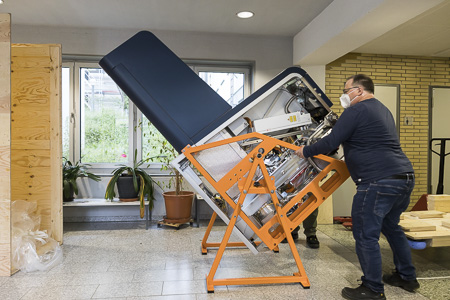
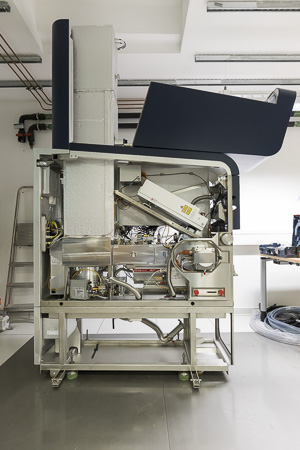
Bruker timsTOF fleX Ordering
By end of January 2021, the Deutsche Forschungsgemeinschaft (DFG) granted a Bruker timsTOF fleX instrument (INST 35/1640-1 FUGG) to OCI. The formal process of instrument acquisition by Heidelberg University has now been finalized by placing an order for this mass spectrometer at Bruker Daltonik GmbH, Bremen.
The new mass spectrometer represents an ion mobility-quadrupole-time-of-flight (IM-Q-TOF) type of instrument. It will be equipped with a ESI-to-MALDI switchable ion source (as we have on the Bruker ApexQe FT-ICR instrument) that is delivering ions from either ionization technique to the mass analyzer via an integrated trapped ion mobility spectrometry (TIMS) stage. Ion mobility separation is based on collision cross section of ions traveling through the gas phase. IMS is performed on the 50-ms timescale, and thus, can effect separation during any analysis. The timsTOF series of instruments is capable of tandem MS, delivers spectra at high resolution, and with accurate mass at very good level (March 2021).
In our lab, the intrument will also be ready to be combined with liquid chromatography and with the DART source (to be adapted).
Installation of the Bruker timsTOF Flex is scheduled in June 2021. (updated April 2021)
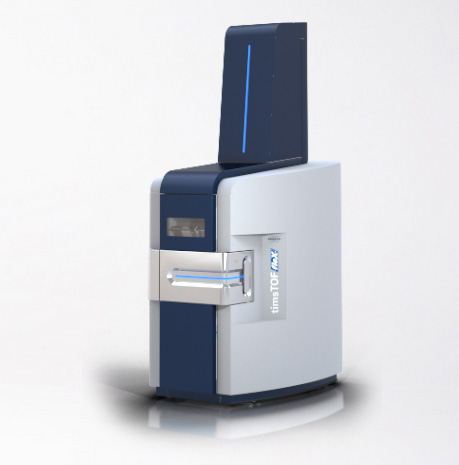
JEOL JMS-700 Removal
The JEOL JMS-700 magnetic sector instrument has served our lab from Apr. 1996 to summer 2019. Now it is being removed from the lab to create empty space that hopefully can be filled with some exciting new instrument in future. With most of the covers unmounted, the complexity of such an instrument as well as the geometry of the mass analyzer become visible (June 2020).
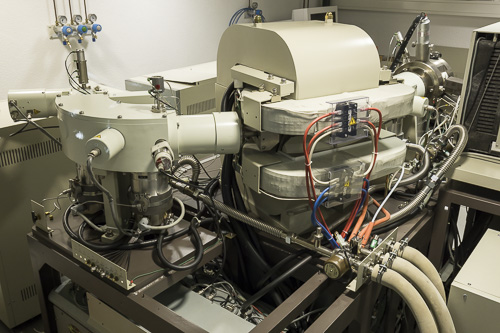
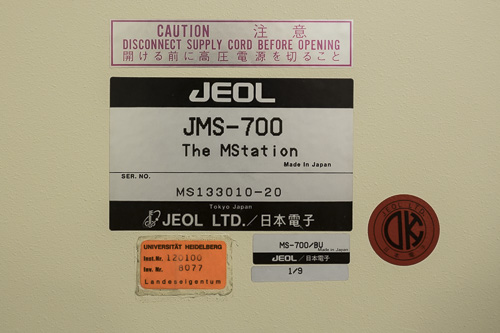
20 Years of MS@OCIHD Website
The website of our MS laboratory celebrates its 20th anniversary. So much has changed in design and appearance since the first version in autumn 1999 until now. Our previous website version is still located at URZ at http://www.rzuser.uni-heidelberg.de/~bl5/. This older website will not be updated anymore. Here is a compilation of the MS@OCIHD websites 1999-2020.
LIFDI Source Added to JEOL AccuTOF
A new version of a FI/FD/LIFDI source for the JEOL AccuTOF instrument has been developed by Linden CMS in collaboration with our lab. This source has finally been installed and can now be used for routine analyses. It replaces the LIFDI source of the JEOL JMS 700 sector instrument that is going to be shut down.
Details on the new LIFDI source are published in Mathias H. Linden, H. Bernhard Linden, Norbert Nieth, Jürgen H. Gross, „Self-Supplied Liquid Injection Field Desorption/Ionization Ion Source for an Orthogonal Time-of-Flight Instrument”, J. Am. Soc. Mass Spectrom. 2019, 30, 2358-2368; article DOI: 10.1007/s13361-019-02297-1 (March 2019).
Bruker AutoFlex Speed Is Beeing Installed
Starting with its delivery on Oct. 5, 2015, the installation of the Bruker AutoFlex Speed mass spectrometer has begun. The instrument is a time-of-flight (TOF) mass spectrometer dedicated to matrix-assisted laser desorption/ionization (MALDI). By mid of the month, we should be ready to run this instrument for MS service (Oct. 2015).
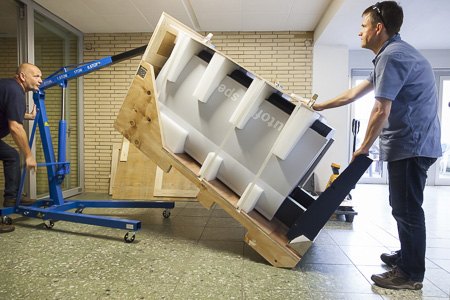
Bruker AutoFlex Speed Ordered
By end of July, we were fortunate enough to order a matrix-assisted laser desorption/ionization (MALDI)- time-of-flight (TOF) mass spectrometer. Within this class of mass spectrometers, the Bruker AutoFlex Speed LRF became the instrument of our choice. This mass spectrometer can be operated in both linear and reflector mode to provide either higher m/z range combined with least possible level of fragment ion peaks or high mass resolving power (depending on m/z up to 26.000 fwhm) and mass accuracy (3-5 ppm can be achieved). Additionally, it provides some basic tandem MS capabilities. Installation of this instrument is scheduled in the first half of October. (Aug. 2015).
JEOL AccuTOF GCx Installed
In July 2015, the installation of a JEOL AccuTOF GCx mass spectrometer, the newest type of this series of compact time-of-flight instruments, equipped with EI and CI sources, direct insertion probe, and gas chromatograph has been finished. Since then, we are using it in EI mode to deliver spectra with accurate mass information of small molecules. CI and GC operation are to follow after a more detailed training by a JEOL specialist later in August. (July 2015)
MALDI-TOF Mass Spectrometer to be Acquired
Our lab is in the process of selecting and acquiring a MALDI-TOF instrument to complement the MALDI option on our Bruker ApexQe-FT-ICR instrument with a quicker and more sensitive device that is also capable of accessing an extremely wide mass range. There is a good chance to have such a spectrometer installed by end of the year. (May 2015).
JEOL AccuTOF GCx on the Way
The JEOL JMS-700 magnetic sector instrument, now operated in its 19th year, is going to be replaced in a stepwise process. As the first step, electron ionization (EI) and chemical ionization (CI) will be moved over to a new instrument. Thus, in January 2015, the institute has ordered a JEOL AccuTOF GCv 4G equipped with EI and CI sources, direct insertion probe, and gas chromatograph. The JEOL AccuTOF GCv 4G is capable of delivering accurate mass for small molecules as typically analyzed by EI and CI. Installation of this new instrument is scheduled end of June 2015 (May 2015).
UPLC-MS Running in Open Access Mode
After some preliminary testing with a limited number of people, the Waters UPLC-MS system is now running in Open Access mode. A brief introduction is required prior to using the instrument. Actually, these short courses (1.5 h) are offered on demand for groups of 3 to 5 people. In future, they will be offered on a regular basis (May 2013).
DART Source on ApexQe
Direct analysis in real time (DART) represents a well-established method of ambient MS, i.e., with DART, samples can be analyzed in the open laboratory environment. To do so, the analyte is simply positioned in front of the API interface while being subjected to an ionizing gas stream.
The DART source has been delivered by IonSense and installed end of January 2013 by KR Analytical. It is currently run in service operation to improve the throughput of organic compounds analysis.
In near future, the DART source willl be made available for access by PhD students after a short training (April 2013).
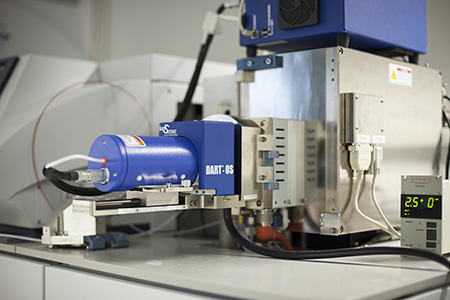
UPLC-MS for Open Access Installed
The Institute of Organic Chemistry has been acquiring an UPLC-MS system comprising a UPCL with autosampler and photodiode detector and a single quadrupole mass analyzer with ESI and APCI combination ion source (Waters Acquity+SQD2). Once its operation is established in early 2013, the system will be run in open access mode for researchers of OCI (Dez. 2012).
LCQ installed to support instrumentation
An about 10-year old Finnigan LCQ - so-called LCQ classic has been acquired from MasCom. the insturment has been installed in our lab to increase the sample throughput and to reduce the impact of instrument failures on the overall capacity of MS@OCIHD (July 2010).
ApexQe Installed
The installation process of our Bruker ApexQe instrument has finally been finished during the first week of January 2007. We will receive an introductory user training during the second week of the month. Then, the ApexQe will be stepwise integrated into our MS service.
The instrument is equipped with electrospray ionization (ESI), matrix-assisted laser desorption/ionization (MALDI) and atmospheric pressure chemical ionization (APCI), the latter being new to our facility. The mass spectrometer offers tandem MS in combination with three activation methods to induce dissocation of the ions (CID, IRMPD and ECD).
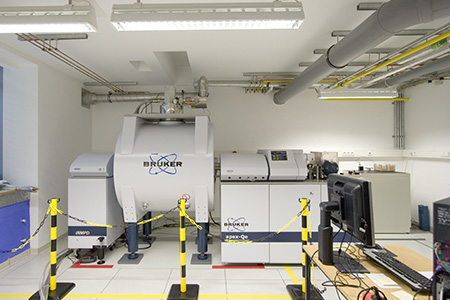
Delivery of Bruker ApexQe
On Nov. 28, 2006 the installation of the Bruker ApexQe instrument started with the delivery of the components, the largest of them being the 9.4 Tesla superconducting magnet. Due to limited floor strength this magnet had to be hoisted to the entrance level of building 274 by a truck-mounted crane.
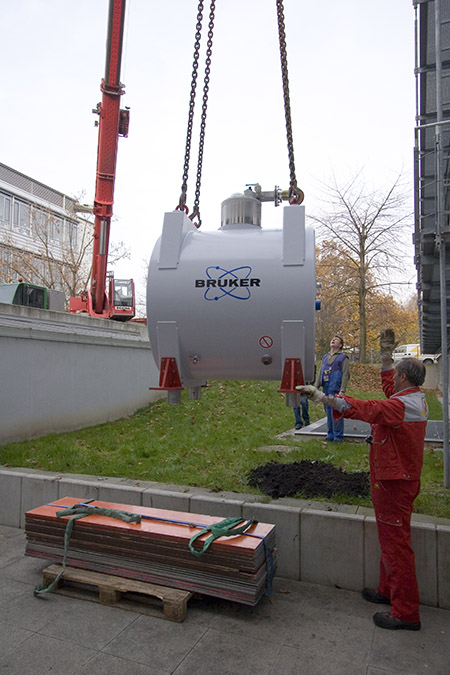
Placement of this 2.7 ton magnet on its four legs inside the lab wasn't a simple procedure either.

LIFDI Acquired for JEOL JMS-700
The liquid injection field desorption/ionization (LIFDI) prototype unit tested in January has been completed and become a commercial product of Linden CMS. Results obtained with the prototype will be published in Anal. Bioanal. Chem. (cf. entry 21) of publications). We have now acquired the finalized product for our JEOL JMS-700 (May 2006).
A liquid injection field desorption/ionization (LIFDI) prototype probe has been installed on our JEOL JMS-700 by Linden CMS for testing. LIFDI enables us to obtain FD mass spectra of compounds sensitive to air and moisture (Jan. 2006).
FT-ICR-MS In Near Future
The Collaborative Research Center (Sonderforschungsbereich 623) "Molecular Catalysts: Structure and Functional Design" established by the German National Science Foundation (DFG) within the Heidelberg Faculty of Chemistry and Earth Sciences in 2002 will be continued until 2009. This second period of SFB 623 also provides funding of a FT-ICR mass spectrometer which will hopefully be installed at our facility in 2006 (June 2005).
We have moved to INF 274
Starting Monday, Jan. 12, 2004, we were moving our instrumentation from INF 271/007 to INF 274/-1.02. The operation was basically completed within one week. Today, Wed. 21, 2004, we are almost back to normal service operation. However, some adjustments and customizations of the new laboratory still need to be done (Jan 2004).
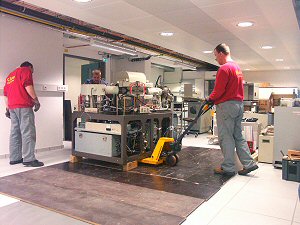
OCI Local MS History until 2002
Our local MS history has been summarized in "Geschichte der Massenspektrometrie am Organisch-Chemischen Institut der Universität Heidelberg", a partially personal view starting back in 1964. Published Feb. 2002.
For more general purpose, A History of Mass Spectrometry can be found at Scripps Research Institute, La Jolla, CA. There is also an article entitled A Brief History of Mass Spectrometry Instrumentation by Stu Borman.
There is also a "Historische Sammlung der instrumentellen Analytik" at TU Clausthal.
VG ZAB-2F uninstalled
The VG ZAB-2F magnetic sector instrument has been uninstalled on April 24th, 2002 by the Grotemeyer group. It will be reinstalled at the University of Kiel for educantional purposes. More about the ZAB-2F and moving of the 2.4 ton device to Kiel can be found on separate pages (Apr. 2002).
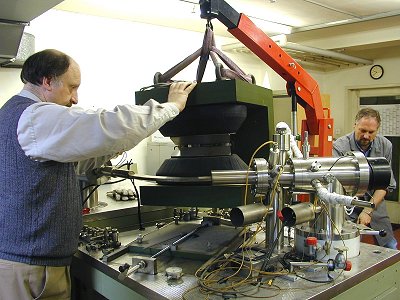
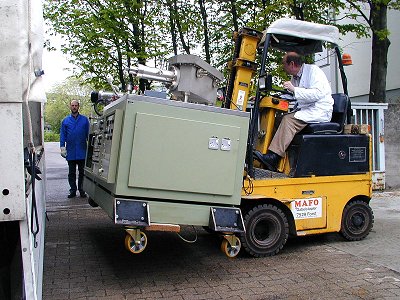
nanoESI source for TSQ700 has been installed
Our triplequadrupole mass spectrometer Finnigan TSQ-700 has been equipped with a nanoESI source to improve sensitivity, and to reduce sample consumption and cross contamination between subsequent samples.
This specific nanoESI source is the first of its kind and is developed by MasCom exclusively for for the Finnigan TSQ and MAT95 series of mass spectrometers. The installation has been finished in Feb. 2002.
Scout26 ion source on Biflex TOF-MS installed
The ion source of the Bruker Biflex MALDI-TOF-MS has been replaced. Instead of the old one having a 10-target probe, the Scout26 ion source has 26 spots for sample preparation and what is more important, can move to any position on the target surface. Thus, it reduces the amount of sample needed for preparation. The exchange has been finished on Nov. 9, 2001.
Installation of TSQ-700
Starting on August 21, 2000 the "new", i.e. second hand, Finnigan TSQ-700 has been installed in our lab.
After full integration in our MS service, this instrument will replace the VG-ZAB-2F. Installation of a new instrument and the period of instruction may cause some delay in our routine service for some time. Please be patient and give us time to get around with this new triple quadrupole mass spectrometer and it's many new possibilities.
Some service spectra have already been measured for you. They can be recognized from their names following the convention TQ-xxxx, e.g. TQ-0011.
Feb. 1999: Pulsed ion extraction installed
The Bruker Biflex MALDI-TOF-MS has been equipped with pulsed ion extraction (PIE) end of February. PIE increases the achievable maximum resolution by a factor of 3-4 in linear mode and 2-3 in reflector mode, i.e. isotopic patterns may be now resolved up to about m/z 3000. This is achieved by inserting a short delay of 50-500 ns between the ion generating laser pulse and the onset of ion acceleration, instead of continuously extracting the ions from the source. During this period the expanding ion cloud will cool down adiabatically from plasma conditions, thus decreasing the spread of the ions kinetic energy.
The example below shows the MALDI-TOF spectra of [60]fullerene having M-. at m/z 720.0 (calc. for the monoisotopic ion). The spectrum on the left side has been acquired in the negative-ion reflector mode of our Biflex without PIE, the right one has been obtained from the same sample using PIE. Both spectra were obtained from 9-nitroanthracene matrix. The value of R is given as RFWHM. PIE does not only result in increased resolution, it also helps to identify peaks of low abundance.
Before 1999
For our MS History prior to 1999 refer to the compilation "Geschichte der Massenspektrometrie am Organisch-Chemischen Institut der Universität Heidelberg", a partially personal view starting back in 1964, which has been published Feb. 2002.



